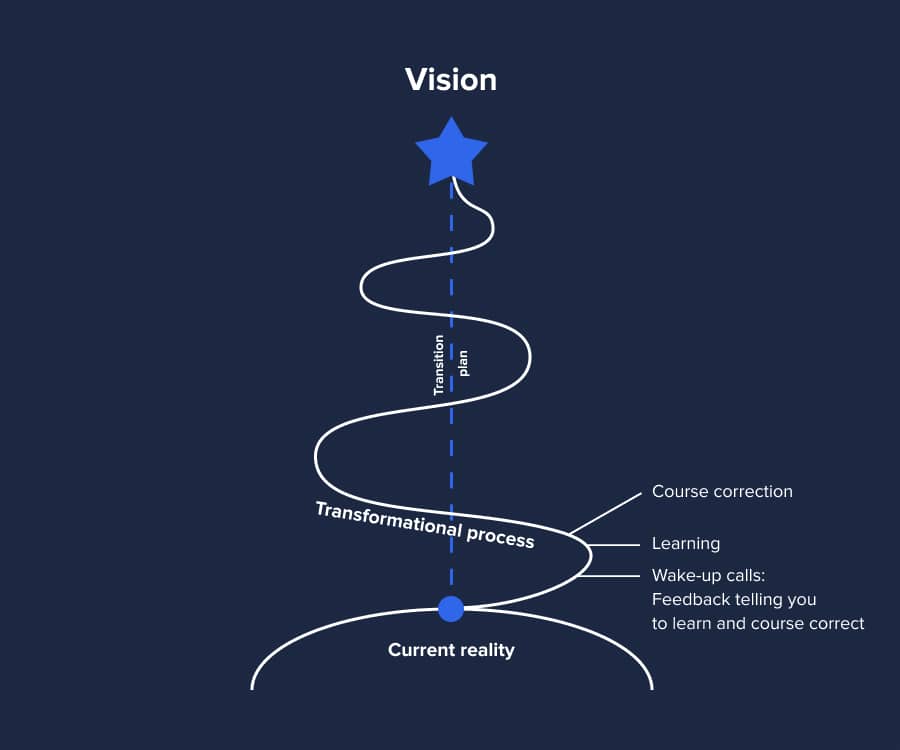
Understanding Agile transformation
Agile transformation refers to the process of an organisation adopting Agile principles and practices across all business levels to become more flexible, adaptive, responsive to change and deliver products and services faster and more efficiently.
Organisations with planning agility are 3.4 times more likely to adjust their plans as fast as disruptions happen. However, only 20% of organizations are engaged enough to be this quick.
It's a common misconception that Agile methodology is primarily for software development and that transformation is simply about applying Scrum or other Agile methods to existing workflows and culture. However, Agile transformation is a much broader concept. It involves aligning leadership around Agile values, fostering a culture of experimentation and learning, empowering teams to self-organise and make decisions, implementing iterative planning and delivery cycles, embracing feedback loops for rapid adaptation, and more.
6 steps to building successful Agile transformation roadmap
Each transformation strategy is unique and influenced by a variety of factors. However, the key condition for having a successful result is the willingness and readiness of company leadership to change the company environment. It means there is an internal understanding that something is wrong and a desire to change the situation. Without this critical mindset, all Agile transformation efforts will encounter obstacles at different levels. Let's dive deeper into this process.
Step 1. Kick-off meetings
Typically, the initial discussions involve one or two key contact points who recognise the transformational value or wish to implement the desired changes. It is beneficial as it allows you to get valuable input before beginning the work, including problem statements, desired outcomes, environment descriptions, and other related details.
While this process may lead to signing a contract that includes the main points highlighted by your partner, it's essential to be aware of the potential downside. This approach may not always provide an accurate understanding of the situation. There are several reasons for this uncertainty:
- You need to ensure you are actually speaking with a decision-maker and leading influencer.
- The perspective provided by this person may be too narrow, only partially reflecting the situation or merely presenting a personal viewpoint.
- There are other leaders and influencers (potentially not of such high ranking), but they are important.
Step 2. Change management team
To avoid possible pitfalls in implementing transformation strategy it's important to involve key leaders early in the process. Your goal is to convince your partner to bring these leaders together for a common workshop, even before signing the contract.
- Reasons to involve leaders early in the process:
-
- They will be part of the change process, and without their support, the effort can not be successful.
- It provides the opportunity to get a broader perspective, benefiting both the Agile coach and the client's manager.
- Leaders will feel that they are respected and their opinion is taken into account from the beginning, which will enhance their understanding and support for the upcoming transformation efforts.
- Early involvement allows for identifying and including provisions in the contract that are more valuable to the client.
- It is a great opportunity to gather all key leaders into a common change management team and agree on the cooperation principles from the start.
It's essential to pay attention to and understand the requirements of the main stakeholders. However, it's equally important for everyone to recognise that they are integral to the transformation and decision-making process.
Step 3. Coaching agreement workshop
As we already mentioned, it is reasonable to conduct a common workshop even before signing the contract. Here are the aspects that should be clarified during the workshop.
Warm-up exercises for identifying delivery problems
A variety of warm-up exercises can be applied during such events, including “Let’s get to know each other.” A useful exercise is to analyse the list of typical delivery problems. It’s interesting to highlight that you can enhance such a list with problems identified by your main contact points during the kick-off meeting. The main goal of this exercise is to identify the most challenging issues for all leaders and provide a more detailed explanation of the problem. Additionally, for top leadership, it serves as a valuable check to confirm if the issues they've identified are genuinely significant and apparent to the entire leadership team.
Consider a situation where the process for learning and improvement is not established. For example, we know that there are many inefficient things/processes, but no discussions occur to highlight them and improve the situation. Moreover, there's no time allocated to solve things that are not working, and issues are not clearly identified. The warm-up may help to reveal a lack of culture to review and steady the process improvements together without retrospectives, sprint reviews, etc. And expectations that problems will be solved by single people, not as a team.
Agile transformation Canvas
Another exercise for the workshop, we would divide into three logical sections:
- Leaders' perception of the Agile transformation: Explore how leaders perceive the importance of Agile transformation. It includes understanding their current behaviours, needs, and the results they expect from adopting Agile practices.
- Agile coach role: Outline what leaders expect from the Agile coach and set up cooperation rules for the change management team.
- Culture and process specifics: Disclosing organisation-related cultural and process specifics that could positively or negatively impact the transformation process.
The output of such workshop should be the list of problems that will form a change roadmap, important items that will be added to the real contract, cooperation principles, and possible transformation risks.
Step 4. Transformation change roadmap
After the workshop, the question arises whether the information gathered sufficient to formulate and prioritise the transformation roadmap. The truth is, it's not, because it solely represents the personal perspectives of leaders.
While the information from the workshop is a good starting point, many other small details can influence our understanding. Therefore, it is highly recommended that we spend several weeks observing all processes inside the transformation environment in real life. Only then can we create a comprehensive list of items requiring future change.
Once the comprehensive list is in hand, can it be considered complete and ready to work with? For the beginning–yes. However, this list of items, even when prioritised, is designed to be flexible. It is intended to be a living document, guided by the stable company transformation goal/vision, and will evolve as the transformation progresses.

Step 5. Arranging work of Change Management Board
As described above, it's better to invite a group of leaders to participate in the workshop to establish the Change Management Board. It is crucial for them to be part of the change process and be able to influence it. These key individuals are crucial for the Agile coach, as they will help support and implement agreed-upon transformation efforts. By influencing the implementation and the people they manage, they play a vital role in ensuring the success of these changes.
It is important to gather them regularly, much like in Agile delivery. It could be every 2-3 weeks, depending on the agreement.
- The goal of such an iterative gathering is:
-
- to define and prioritise what should be changed during the next iteration and the people responsible for this;
- to demonstrate a tangible, measurable result. It is vital to reinforce the feeling that we are in the right direction, we have positive results, and we would like to enhance change process visibility and support;
- to obtain credit of trust for the next steps;
- to analyse/discuss results and lessons learnt and decide regarding the next vital steps.
Step 6. Leading changes and coaching
The Agile coach plays an important and multifaceted role here. Firstly, the coach is responsible for training individuals and establishing necessary Agile processes. There is always a need to share knowledge and teach people. Additionally, the coach must observe how Agile practices are implemented in real-life situations, identify problems or misunderstandings, and assist in finding solutions. Last but not least, Agile coaches need to encourage people to practice Agile in their daily routines and foster the customer-centred mindset. It involves building a customer-centric culture throughout the whole organisation by consistently practising Agile principles.
Learn more about Agile team roles and responsibilities: Decoding the Roles: Scrum Master vs Project Manager vs Agile Delivery Lead

Key takeaways
The Agile transformation journey is a complex and flexible process that is, of course, unique to each company. The Agile coach plays a vital role in training, problem-solving, and fostering a customer-centric culture. However, the key to success is the willingness and readiness of company leadership to embrace changes.
Forming a change management team early on is crucial to gather diverse perspectives and secure leader support. This support will encourage people to use repetitive Agile practices, which is essential for creating an appropriate Agile culture. In essence, transformation is a continuous process. It is difficult to expect it to be finished soon, as markets are dynamic and changes are constantly required. The main thing is to form an appropriate, flexible, and adaptive culture, allowing the company to be ready to react to or even predict new challenges.

FAQs
You should start by understanding your current processes and challenges. Then, create a tailored plan to implement Agile practices, focusing on training your team, setting up Agile tools, and fostering a culture of continuous improvement.
An Agile transformation roadmap is a strategic plan that outlines the steps and milestones for adopting Agile practices in an organisation. It includes initial assessments, training programs, pilot projects, scaling strategies, and ongoing evaluation to ensure the transformation is successful and sustainable.
The Agile transformation flow involves assessing the current state, planning the transformation, training and coaching teams, implementing Agile practices in stages, and continuously monitoring and improving the process to ensure it meets the organisation’s goals and adapts to changes.
Related Insights











